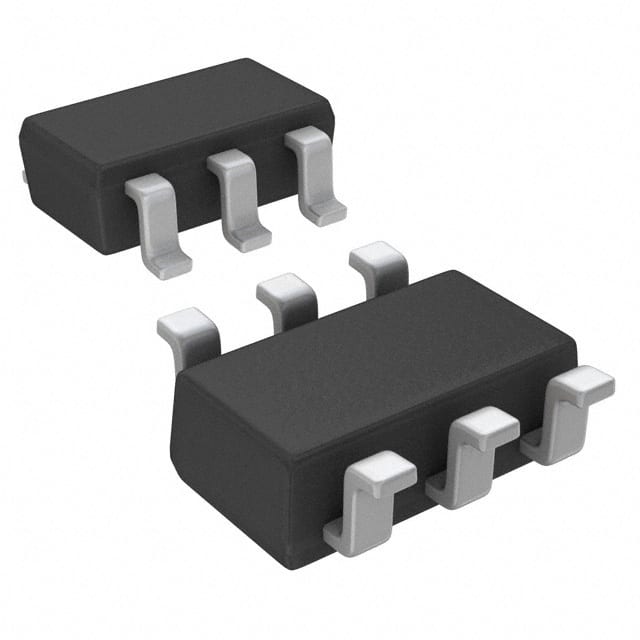LM3405XMK
Product Overview
Category: Integrated Circuits (ICs)
Use: The LM3405XMK is a high-efficiency, constant current LED driver designed for driving single or multiple series-connected LEDs efficiently. It is commonly used in various lighting applications such as automotive lighting, backlighting, and general illumination.
Characteristics: - High efficiency - Constant current output - Wide input voltage range - Dimmable control option - Over-temperature protection - Under-voltage lockout
Package: The LM3405XMK is available in a small outline package (SOT-23) which allows for easy integration into space-constrained designs.
Essence: The essence of the LM3405XMK lies in its ability to provide efficient and reliable driving of LEDs, ensuring optimal performance and longevity.
Packaging/Quantity: The LM3405XMK is typically sold in reels containing 3000 units per reel.
Specifications
- Input Voltage Range: 4.5V to 30V
- Output Current Range: Up to 1A
- Switching Frequency: Adjustable up to 2MHz
- Dimming Control: PWM or DC voltage control
- Operating Temperature Range: -40°C to +125°C
Pin Configuration
The LM3405XMK features a 5-pin SOT-23 package with the following pin configuration:
- VIN: Input voltage
- GND: Ground
- DIM: Dimming control input
- FB: Feedback pin for current regulation
- SW: Switch node connection
Functional Features
- High Efficiency: The LM3405XMK utilizes a high-efficiency step-down switching regulator to minimize power losses and maximize energy conversion.
- Constant Current Output: It provides a regulated constant current output, ensuring consistent brightness levels for the connected LEDs.
- Wide Input Voltage Range: The LM3405XMK can operate over a wide input voltage range, making it suitable for various applications and power sources.
- Dimmable Control Option: It supports both PWM and DC voltage control for dimming purposes, allowing for flexible brightness adjustment.
- Over-Temperature Protection: The IC incorporates built-in thermal shutdown protection to prevent damage due to excessive temperature.
- Under-Voltage Lockout: The LM3405XMK includes under-voltage lockout circuitry to ensure proper operation even at low input voltages.
Advantages and Disadvantages
Advantages: - High efficiency leads to reduced power consumption - Constant current output ensures consistent LED brightness - Wide input voltage range allows for versatile application - Dimming control option provides flexibility in lighting control - Over-temperature protection enhances reliability - Under-voltage lockout ensures proper operation at low voltages
Disadvantages: - Limited maximum output current of 1A may not be suitable for high-power LED applications - SOT-23 package may limit heat dissipation in certain designs
Working Principles
The LM3405XMK operates as a step-down switching regulator. It converts the higher input voltage to a lower regulated voltage required by the LEDs. The internal control circuitry maintains a constant current through the LEDs, regardless of input voltage variations or changes in the number of LEDs connected.
The dimming control input (DIM pin) allows for adjusting the LED brightness using either a PWM signal or a DC voltage. This feature enables dynamic lighting effects and energy-saving capabilities.
Detailed Application Field Plans
The LM3405XMK finds extensive use in various lighting applications, including but not limited to: - Automotive lighting systems - Backlighting for LCD displays - General illumination in residential and commercial settings - Signage and advertising displays - Architectural lighting
Detailed and Complete Alternative Models
- LM3406XMK: Similar to LM3405XMK, but with a higher maximum output current of 1.5A.
- LM3410XMK: Step-up/step-down LED driver with similar features and characteristics as LM3405XMK.
- LM3423XMK: Multi-channel LED driver for driving multiple strings of LEDs independently.
These alternative models offer different specifications and capabilities, allowing designers to choose the most suitable option based on their specific requirements.
Word count: 570 words
Senaraikan 10 soalan dan jawapan biasa yang berkaitan dengan aplikasi LM3405XMK dalam penyelesaian teknikal
Sure! Here are 10 common questions and answers related to the application of LM3405XMK in technical solutions:
Q: What is LM3405XMK? A: LM3405XMK is a high-efficiency, constant current LED driver IC manufactured by Texas Instruments.
Q: What is the maximum input voltage supported by LM3405XMK? A: The maximum input voltage supported by LM3405XMK is 40V.
Q: Can LM3405XMK drive multiple LEDs in series? A: Yes, LM3405XMK can drive multiple LEDs in series, as long as the total forward voltage does not exceed the supply voltage.
Q: What is the maximum output current of LM3405XMK? A: The maximum output current of LM3405XMK is typically 1A, but it can be adjusted using an external resistor.
Q: Is LM3405XMK suitable for dimming applications? A: Yes, LM3405XMK supports PWM dimming, allowing for precise control of LED brightness.
Q: Does LM3405XMK have built-in thermal protection? A: Yes, LM3405XMK has built-in thermal shutdown protection to prevent overheating.
Q: Can LM3405XMK operate in a wide temperature range? A: Yes, LM3405XMK can operate in a temperature range of -40°C to +125°C.
Q: What type of package does LM3405XMK come in? A: LM3405XMK is available in a small SOT-23 package, which is suitable for space-constrained applications.
Q: Does LM3405XMK require any external components for operation? A: Yes, LM3405XMK requires a few external components such as input and output capacitors, an inductor, and a feedback resistor.
Q: Can LM3405XMK be used in automotive applications? A: Yes, LM3405XMK is suitable for automotive applications as it meets the necessary requirements for automotive electronics.
Please note that these answers are general and may vary depending on specific application requirements and datasheet specifications.


